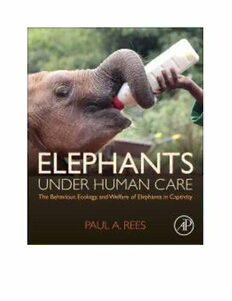
Elephants under human care : the behaviour, ecology, and welfare of elephants in captivity PDF
Preview Elephants under human care : the behaviour, ecology, and welfare of elephants in captivity
ELEPHANTS UNDER HUMAN CARE ELEPHANTS UNDER HUMAN CARE The Behaviour, Ecology, and Welfare of Elephants in Captivity P A. R AUL EES SchoolofScience,EngineeringandEnvironment,UniversityofSalford,UnitedKingdom AcademicPressisanimprintofElsevier 125LondonWall,LondonEC2Y5AS,UnitedKingdom 525BStreet,Suite1650,SanDiego,CA92101,UnitedStates 50HampshireStreet,5thFloor,Cambridge,MA02139,UnitedStates TheBoulevard,LangfordLane,Kidlington,OxfordOX51GB,UnitedKingdom Copyright©2021ElsevierInc.Allrightsreserved. Nopartofthispublicationmaybereproducedortransmittedinanyformorbyanymeans,electronicormechanical, includingphotocopying,recording,oranyinformationstorageandretrievalsystem,withoutpermissioninwritingfromthe publisher.Detailsonhowtoseekpermission,furtherinformationaboutthePublisher’spermissionspoliciesandour arrangementswithorganizationssuchastheCopyrightClearanceCenterandtheCopyrightLicensingAgency,canbe foundatourwebsite:www.elsevier.com/permissions. ThisbookandtheindividualcontributionscontainedinitareprotectedundercopyrightbythePublisher(otherthanasmay benotedherein). Notices Knowledgeandbestpracticeinthisfieldareconstantlychanging.Asnewresearchandexperiencebroadenour understanding,changesinresearchmethods,professionalpractices,ormedicaltreatmentmaybecomenecessary. Practitionersandresearchersmustalwaysrelyontheirownexperienceandknowledgeinevaluatingandusingany information,methods,compounds,orexperimentsdescribedherein.Inusingsuchinformationormethodstheyshouldbe mindfuloftheirownsafetyandthesafetyofothers,includingpartiesforwhomtheyhaveaprofessionalresponsibility. Tothefullestextentofthelaw,neitherthePublishernortheauthors,contributors,oreditors,assumeanyliabilityforany injuryand/ordamagetopersonsorpropertyasamatterofproductsliability,negligenceorotherwise,orfromanyuseor operationofanymethods,products,instructions,orideascontainedinthematerialherein. BritishLibraryCataloguing-in-PublicationData AcataloguerecordforthisbookisavailablefromtheBritishLibrary LibraryofCongressCataloging-in-PublicationData AcatalogrecordforthisbookisavailablefromtheLibraryofCongress ISBN:978-0-12-816208-8 ForInformationonallAcademicPresspublications visitourwebsiteathttps://www.elsevier.com/books-and-journals Publisher:CharlotteCockle AcquisitionsEditor:AnnaValutkevich EditorialProjectManager:BillieJeanFernandez ProductionProjectManager:JoyChristelNeumarinHonestThangiah CoverDesigner:MatthewLimbert TypesetbyMPSLimited,Chennai,India Contents Acknowledgements xiii 2. Ethological data collection and Preface xv elephant activity budgets Who is this book for? xvii 2.1 Introduction 29 ‘Zoo elephant’ or ‘elephant living in a 2.2 Methodology 29 zoo’: a note on terminology xix 2.2.1 Identifyingindividuals 29 2.2.2 Studyingelephantsinzoos 31 1. Elephants and their relationship with 2.2.3 Ethograms 34 humans 2.2.4 Methodologicaldifficulties 36 2.2.5 Datacollectionbycaregivers 38 1.1 Anotherbookaboutelephants 1 2.3 Activitybudgets 39 1.2 Whatisanelephant? 3 2.3.1 Introduction 39 1.2.1 Elephanttaxonomy 3 2.3.2 Feeding 43 1.3 Conservationstatus 7 2.3.3 Dusting 45 1.3.1 ThestatusofAsianelephantsinthe 2.3.4 Walking 46 wild 7 2.3.5 Resting,sleepingandnocturnal 1.3.2 ThestatusofAfricanelephantsinthe behaviour 46 wild 7 2.4 The24-hourneedsofelephantsinzoos 50 1.4 Thehumanuseofelephants 8 1.4.1 Elephantsinancienttimes 8 3. Elephant social structure, behaviour 1.4.2 Haveelephantsbeen and complexity domesticated? 9 1.4.3 Ceremonialandreligioususeof 3.1 Introduction 51 elephants;elephantsasgifts 9 3.2 Thestructureofelephantsocieties 51 1.4.4 Theuseofelephantsfortransportation 3.2.1 Elephantsocietiesinthewild 51 andasweaponsofwar 10 3.2.2 Elephantsocietiesincaptivity 53 1.4.5 Elephantsandforestryoperations 13 3.2.3 Socialbehaviourandbreeding 59 1.4.6 Elephantsasentertainers:circuses,sports 3.3 Associationsbetweenindividualsand andtourism 13 friendships 59 1.4.7 Elephantsasambassadorsfor 3.4 Introductionsintoanelephantgroup 63 conservation 14 3.5 Protectiveformations 64 1.5 Thebeginningofelephantresearch 15 3.6 Dominancehierarchies 66 1.5.1 Aristotleandelephants 15 3.7 Aggression,appeasementandchastisement 68 1.5.2 Anatomicalresearch 18 3.8 Personality 76 1.5.3 Anecdotesasasourceofknowledge aboutelephants 24 4. Elephant reproductive biology 1.5.4 Papersinacademicjournals 25 1.5.5 Earlyphysiologicalresearch 25 4.1 Introduction 81 1.6 Unacceptableelephantscience 26 4.2 Historicalaccountsofsexualbehaviour 81 1.7 Captiveelephantsasproxiesforwild 4.3 Courtshipandmatingbehaviour 83 elephants 27 4.4 Chemicalcontrolofreproduction 88 ix x Contents 4.4.1 Musth 88 6.2.2 Acclimatisationtonew 4.4.2 Endocrinemonitoringoffemales 89 environments 130 4.5 Behaviouralindicatorsofoestrus 90 6.2.3 Thermoregulation 130 4.6 Gestation,pregnancymanagementand 6.3 Feedingecologyandenergetics 133 birth 91 6.3.1 Foodpreferences 133 4.7 Parentingandcalfdevelopment 93 6.3.2 Feedingmethods 134 4.7.1 Developmentalmilestonesandbirth 6.3.3 Calculatingfoodconsumption 134 statistics 93 6.3.4 Digestibility 137 4.7.2 Parentingandallomothering 94 6.3.5 Foodpassagetime 137 4.7.3 Theeffectofacalfonsocial 6.3.6 Defaecation 139 interactionsintheherd 99 6.3.7 Foodsupplementation 139 4.8 Earlysexualbehaviour 100 6.4 Energetics 140 4.8.1 Earlymalesexualbehaviour 100 6.5 Exhibitdesignandenclosureuse 141 4.8.2 Juvenilemounting 100 6.5.1 Introduction 141 4.9 Reproductivechallengesandsolutions 106 6.5.2 Enclosureuse 142 4.9.1 Acyclicityandspermquality 106 6.5.3 Substrateandindoorversusoutdoor 4.9.2 Obstetricsandbirthingproblems 109 preferences 146 4.9.3 Newtechniquesinreproductive 6.5.4 Multispeciesexhibits 148 physiology 109 6.5.5 Rotationalexhibits 149 6.5.6 Elephantsasagentsoflandscapechange 5. Elephant cognition, communication inzoos 150 and tool use 6.6 Populationecology 153 6.6.1 Introduction 153 5.1 Introduction 113 6.6.2 Agedeterminationfromteeth 154 5.2 Cognition 113 6.6.3 Longevityandlifeexpectancyin 5.2.1 Historicalperspectives 113 zoos 154 5.2.2 Self-awareness:doelephantsknow 6.6.4 Birthratesandcalfsurvival 155 theyexist? 114 6.6.5 Sexualmaturityandmeancalving 5.2.3 Discriminationbetweenobjectsand interval 157 betweenquantities 116 6.6.6 ReproductiveperformanceofAsian 5.2.4 Insightfulbehaviour 116 campelephants 158 5.2.5 Pointing 116 6.6.7 Reproductivecessationandthe 5.2.6 Memory 117 ‘motherhypothesis’ 161 5.3 Communication 118 6.6.8 Sustainabilityofzoopopulations 161 5.3.1 Introduction 118 6.6.9 Importationofelephantsfromrange 5.3.2 Vocalcommunication 119 states 162 5.3.3 Humanspeechimitation 120 6.7 Genetics 163 5.3.4 Chemicalcommunication 120 6.7.1 Introduction 163 5.3.5 Tactileandseismic 6.7.2 Interspecifichybridisation 164 communication 123 6.7.3 Intraspecifichybridisation 164 5.4 Visualacuityandvisualdiscrimination 123 6.7.4 Geneticdiversity 164 5.5 Tooluse 124 5.6 Knowingwhentocooperate 127 7. Elephant welfare 6. Elephant ecology and genetics 7.1 Historicalperspectives 169 7.2 Measuringelephantwelfare 173 6.1 Introduction 129 7.2.1 Whatiswelfare? 173 6.2 Ecophysiology 129 7.2.2 Howcanwelfarebemeasured? 173 6.2.1 Introduction 129 7.2.3 Population-levelwelfareindices 175 xi Contents 7.2.4 Bodyweightandconditionscoring 176 8.5.4 Freeversusprotectedcontact 248 7.2.5 Thewelfareofelephantsworkingin 8.6 Transportation 250 tourism 179 7.2.6 Stressanddistress 180 9. Ethics, pressure groups and the law 7.2.7 Behaviourasawelfareindicator 181 7.2.8 Stereotypicbehaviours 183 9.1 Introduction 259 7.3 Environmentalenrichment 194 9.2 Isitethicaltokeepelephantsin 7.3.1 Definingenvironmental captivity? 259 enrichment 194 9.3 Pressuregroups 264 7.3.2 Foodandforagingasenrichment 196 9.4 Law 266 7.3.3 Substratumandtreesas 9.4.1 Introduction 266 enrichment 199 9.4.2 Ivoryinhumanownership 266 7.3.4 Waterasenrichment 202 9.4.3 TheUNConventiononBiological 7.3.5 Sleep,restandenrichment 202 DiversityandtheIUCN 268 7.3.6 Sound,musicandartas 9.4.4 Elephants,zoosandthelaw 270 enrichment 205 9.4.5 Thelawandelephantsinprivate 7.3.7 Interactivetoys 206 ownership 271 7.3.8 Improvingelephantwelfarethrough 9.4.6 Elephants,entertainmentandthe breeding 206 law 272 7.3.9 Socialcontact:theultimatein 9.4.7 Legalpersonhoodandhabeas enrichment 207 corpus 274 7.4 Training 207 9.4.8 Elephantcrueltyandcruel 7.5 Locomotionandgait 208 methods 275 7.6 Obesity 210 9.4.9 Zoosandthewildlifetrade 278 7.7 Disease 211 9.4.10 Arighttocompanionshipand 7.7.1 Introduction 211 retirement 282 7.7.2 Histology 213 9.4.11 Financialsupportforinsitu 7.7.3 Foothealth 214 conservation 284 7.7.4 Tuberculosis 216 7.7.5 Elephantendotheliotropic 10. The conservation value of captive herpesviruses 217 elephants 8. Housing and handling elephants 10.1 Introduction 287 10.2 Thepopularityofelephantsinzoos 290 8.1 Introduction 219 10.3 Zooelephantsasinsurancepopulations 294 8.2 Wildelephantdeclineandtheestablishment 10.3.1 Introduction 294 ofexsitubreedingprogrammes 219 10.3.2 TheSpeciesSurvivalPlaninNorth 8.3 Elephantenclosures 222 America 295 8.3.1 Housingandcontainment 222 10.3.3 TheEuropeanEndangeredspecies 8.3.2 Earlyelephanthouses 223 Programme 295 8.3.3 Enclosuresizeandsubstratum 229 10.3.4 Arezooelephantpopulations 8.3.4 Newenclosures 237 sustainable? 296 8.4 Thecostofkeepingelephantsundergood 10.4 Scientificresearch 297 welfareconditions 238 10.5 Thedevelopmentoftechnologiesrelevantto 8.5 Elephantsandtheircaretakers 243 fieldconservation 298 8.5.1 Keeper(cid:1)elephantbonds 243 10.6 Educationalfunction 300 8.5.2 Traditionalelephantexpertiseversuszoo 10.7 Professionaltrainingoflocalconservationists husbandry 244 andassociatedtechnologytransfer 306 8.5.3 Keeperandmahoutdeaths 246 10.8 Fundraisingforinsituconservation 307 xii Contents 10.9 Dozooandconservationauthoritiessupport 11.8 Cloning 320 captivebreedinginzoos? 308 11.9 Elephantsastherapy 320 10.10 Captivebreedinginrangestates 309 11.10 Climatechange 321 10.11 ‘Domestication’ofAfricanelephants 310 11.11 Aroleforzoos? 321 10.12 Conclusion 310 11.12 Consumptiveuseorintensiveprotection zones? 324 11. The future of elephants in captivity 11.13 Thecourtofpublicopinion 326 11.14 Predictions 326 11.1 Introduction 313 Postscript 327 11.2 Elephantranching 313 11.3 Rewilding(cid:1)shadesofJurassicPark 315 Appendix 329 11.4 Releasetothewild 316 Glossary 333 11.5 Welfareconcerns 317 References 341 11.6 Sanctuaries 317 11.7 Arepositoryofusefulgenes 318 Index 379 For Katy, Clara and Elliot (cid:1) my Little Toomai
